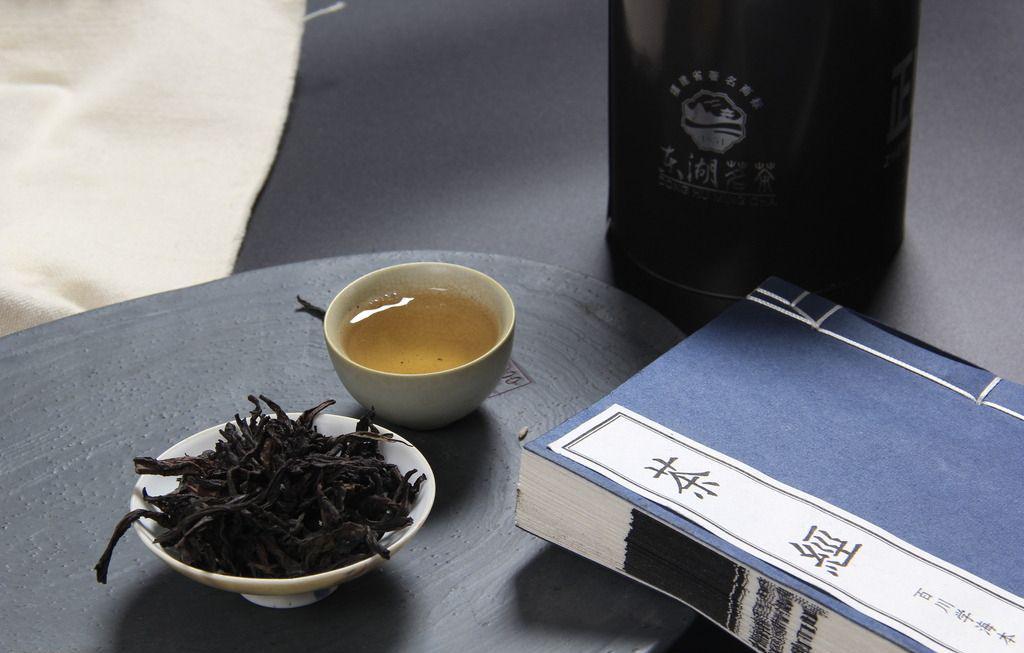The Classic of Tea, the world’s first-known, best-preserved and most complete monograph on tea, was written by Chinese famous tea scholar Lu Yu. The book is honored as “The Encyclopedia of Tea”, which involves the history, origination, development, status quo and production technology of tea as well as the tea arts and tea ceremonies. It is a monograph on tea science, a masterpiece of agriculture science, and a book on tea culture. It is the book that brings tea to a level of arts, thereby promoting the development of Chinese tea culture.
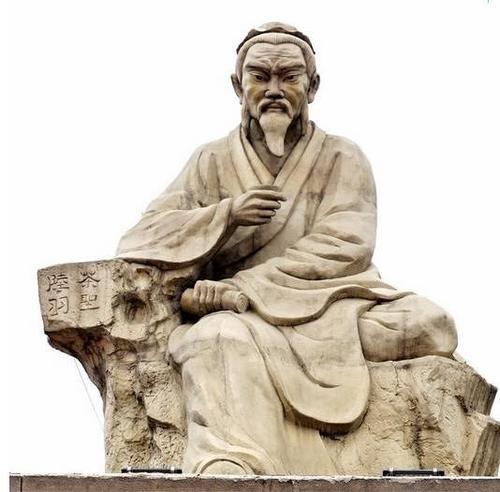
Lu Yu was born in 733 A.D. in Jingling, Fuzhou (now Tianmen City, Hubei Province, China). He was a famous tea scholar of the Tang Dynasty and honored as “The Sage of Tea”. He was adopted into a Buddhist temple at a very young age. Lu Yu has studied hard since childhood. So, he soon became knowledgeable and was good at writing poetry. When he grew up, he was aloof from politics and material pursuits and did not value power and wealth in his lifetime. In 760 A.D., Lu Yu lived in seclusion in Tiaoxi (now Huzhou City, Zhejiang Province, China) to escape Au Lushan Rebellion. During that period, he studied tea leaves in person and summarized his predecessors’ experience in processing tea leaves. Through hard work and dedication, Lu Yu completed his masterpiece – The Classic of Tea.
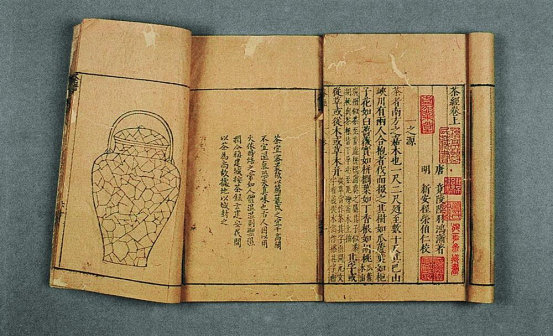
The Classic of Tea consists of three volumes or ten articles. Article 1 is about the origin and characteristics of tea. Article 2 is about the utensils for plucking and processing tea leaves. Article 3 is about the types and processing methods of tea leaves. Article 4 is about the utensils for boiling tea leaves and drinking tea liquid. Article 5 is about the methods for brewing tea leaves and evaluating water quality. Article 6 is about the customs for drinking and tasting tea liquid. Article 7 is about the anecdotes and medicinal effects of tea leaves. Article 8 is about the tea-producing areas. Article 9 is about the conditions for using tea utensils. Article 10 is about the white silk recording the whole process of plucking tea leaves, processing tea leaves and drinking tea liquid.
Tea is a kind of superior trees grown in southern China. It is one or two Chi in height. Sometimes it can grow up to dozens of Chi in height. In Bashan and Xiachuan grow tea trees that take two people to embrace. The tea buds and leaves cannot be plucked until you cut the branch off.
Tea trees are in the shape of a cucumis melo. Tea leaves are in the shape of gardenia. Tea flowers look like white roses. Tea seeds look like palm. Fruit stems look like Syzygium aromaticum. Roots look like walnuts.
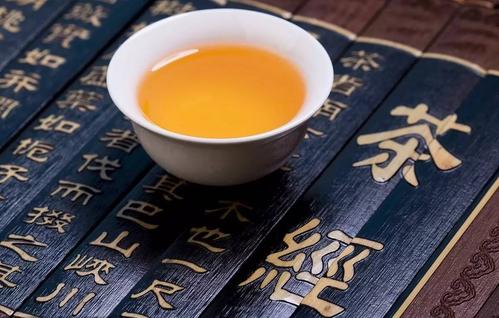
Tea has five names, namely Cha (茶), Jia (槚), She (蔎), Ming (茗) and Chuan (荈).
As for as the soil to grow tea trees, the sufficiently efflorescent rocky soil is the best, the sandy loam soil is the second-best, and the yellow clay is the third-best.
Generally speaking, if the young tea trees are transplanted in an improper manner, they will be less likely to thrive. The method of planting tea trees is like that of melons. Tea leaves can be plucked three years after the planting of tea trees. Tea trees naturally grown in mountains produce the best tea leaves, while the ones grown in gardens produce the second-best tea leaves. If the tea trees grow on the hillside exposed to the sun, the purple tea leaves are the best and the green ones are the second-best. Tea trees grown on the shady hillside produce no high-quality tea leaves, which are not worth plucking.
Tea is cold in nature and effective for clearing heat, quenching thirst and relieving headache. However, if the tea leaves are not high-quality or mixed up with weeds or rotten leaves, people who drink the tea liquid will get ill.
Just like ginseng, the quality of tea leaves varies depending on production areas. The inferior tea liquid may have harmful effects on human body.
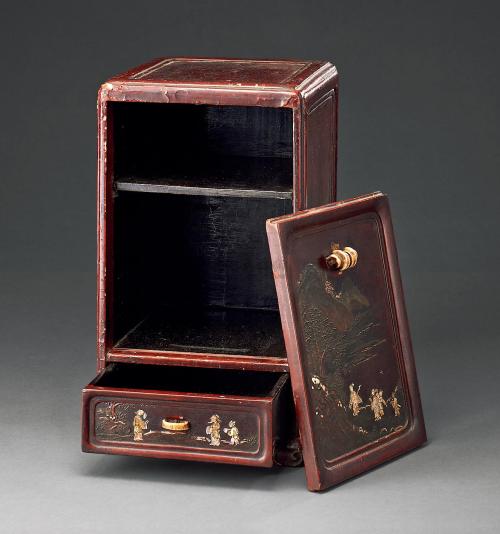
Ying (籯), also known as Lan (篮), Long (笼) or Ju (筥), is a bamboo basket. With a capacity of five litres, it is used by tea growers to hold tea leaves.
Zao (灶) is a kind of oven without a chimney.
Zeng (甑) is an ancient wooden or ceramic cooker. There is a bamboo basket inside the cooker. Put tea leaves in the bamboo basket for steaming.
Wu Jiu (忤臼), also known as Dui (碓), is used to grind the steamed tea buds and leaves.
Gui (规), also known as Mo (模) or Quan (棬), is used to press tea leaves into different shapes, such as round shape, square shape and flower shape. It is made of iron.
Cheng (承), also known as Tai (台) or Zhen (砧), is made of stone and used to support other tea utensils.
Yan (檐), also known as Yi (衣), is used to produce compressed tea such as compressed cake teas.
Bi Li (芘莉), also known as Ying Zi (籯子) or Pang Lang (篣筤), is a bamboo ware used to hold tea leaves.
Qi (棨), also known as Zhui Dao (锥刀), is made of solid wood and used to pierce cake teas.
Pu (扑), also known as Bian (鞭), is made of bamboo and used to string cake teas together.
Bei (焙) is a pit surrounded by low walls.
Guan (贯) is made of bamboo and used to bake tea leaves.
Peng (棚), also known as Zhan (栈), is a wooden shelf placed on Bei (焙) to bake tea leaves.
Chuan (穿) is made of bamboo or bark and used to string cake teas together.
Yu (育) is a wooden frame wrapped by thin bamboo strips and paper. It is used as a dehumidifier.
Tea growers usually pluck tea leaves in February-April based on the calendar of the Tang Dynasty. In the morning, tea growers pluck stout and strong tea buds and leaves from tea trees grown in the efflorescent rocky soil. Tea buds and leaves cannot be plucked if it is rainy or cloudy. They can only be plucked when it is sunny. Put the plucked tea buds and leaves in Zeng (甑) for steaming. Use Wu Jiu (忤臼) to grind the steamed tea buds and leaves. Put the ground tea buds and leaves in Gui (规) and press them with hands into certain shapes. And then bake them and string them together. Tea leaves can then be kept dry.
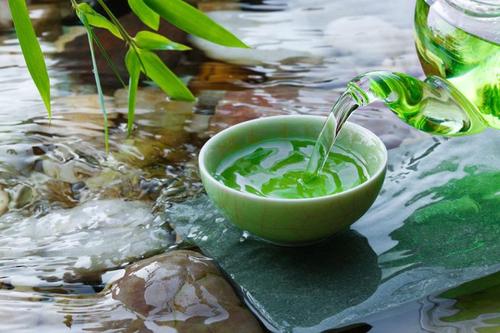
Tea leaves come in different shapes. Some of them look like the crumpled leather boots of the Northern barbarian tribes in ancient China. Some of them look like brisket and have fine folds. Some of them look like floating clouds. Some of them look like water ripples. Some of them are smooth and glossy. Some of them are uneven. But all of these tea leaves are with high quality. It is hard to steam and grind the tea leaves that look like bamboo shoot shells. So, some of the tea products look like frost-blighted lotus leaves. These are inferior tea leaves.
From plucking to packaging, tea leaves are processed through seven steps. Tea leaves can be divided into eight grades, from those looking like the crumpled leather boots to those looking like frost-blighted lotus leaves. Some tea lovers regard smooth, black tea leaves as high-quality ones. But it is the third-best method to evaluate the quality of tea leaves. Some tea lovers regard crumpled, yellow and uneven tea leaves as high-quality ones. Similarly, it is the second-best method. Then, what is the best method? The best evaluators are able to point out both advantages and disadvantages of the tea leaves. The reasons are as follows: After the tea leaves are processed and produce tea liquid, they will be smooth and glossy. If tea leaves remain unprocessed, they will be crumpled. If the tea leaves are processed overnight, their color will be black. If the tea leaves are processed on the same day, their color will be yellow. If the steamed tea leaves are pressed tightly, they will be smooth. If tea leaves are not pressed tightly, they will be rough and uneven. These characteristics of tea leaves are the same as that of grass, trees and other leaves.
Feng Lu (风炉) is made of copper or iron and looks like an ancient tripod. It is used to ventilate the stove, hold the charcoal ash and brew tea leaves.
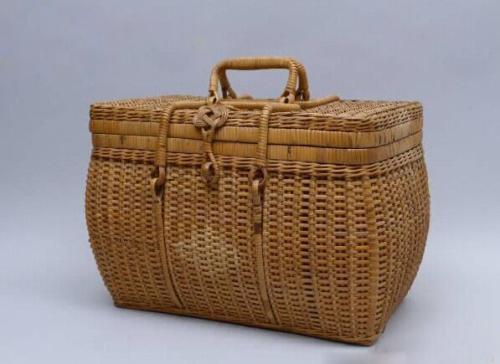
Ju (筥) is made of bamboo and one Chi two Cun in height. It is used as a bamboo basket.
Tan Wo (炭挝) is made of hexagonal iron bars and one Chi in length. It is used as a hammer to smash charcoal.
Huo Jia (火夹), also known as Zhu (箸), is actually coal tongs. It is made of iron or wrought copper.
Fu (鍑) is made of cast iron and used as a saucepan.
Jiao Chuang (交床) is made of a wooden cross and used to support the saucepan.
Jia (夹) is made of green bamboo and one Chi two Cun in length. It is used to carry cake teas baked over the fire.
Zhi Dai (纸袋) is made of two pieces of white, thick rattan paper and used to hold baked tea leaves.
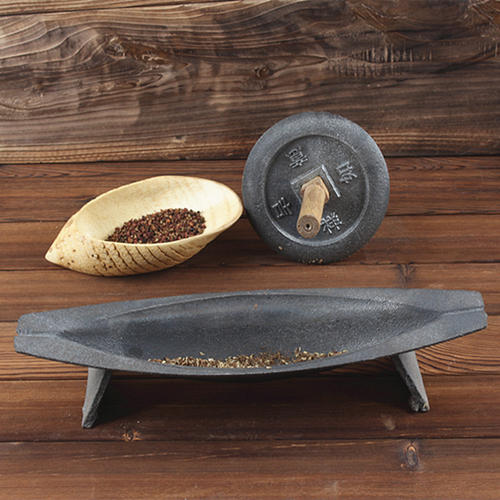
Nian Cao (碾槽) is mainly made from tangerine trees. It is used as a mill groove.
Luo (罗), with a round shape, is made of giant bamboo. Cotton or silk is fixed at the bottom of Luo. He (盒) is also made of bamboo and bended into a round shape. Luo (罗) is used to sieve out tea powder which is put into He (盒). Ze (则) is made of seashells, copper, iron, or bamboo. It is the metric to take tea powder. It is used as a tea spoon. If you like to drink light tea, put less tea powder. If you like to drink thick and mellow tea, put more tea powder.
Shui Fang (水方) is a wooden water container, with a capacity of one Dou (斗). The internal and external gaps of the water container are painted.
Lu Shui Nang (漉水囊) is used for the filtration of water. Its skeleton is made of cast copper, bamboo or wood. Its filtration bag is made of bamboo skin.
Piao (瓢), also known as Xi (牺) or Shao (杓), is mainly made of a gourd. It is used to scoop up water.
Zhu Jia (竹夹) is made of wood and one Chi in length. It is used to store the tea cup.
Cuo Gui (鹾簋) is made of porcelain. It can be in the shape of a box, bottle or jar. It is used to hold salt. Jie (揭) is made of bamboo and used to scoop up salt.
Shu Yu (熟盂) is made of porcelain or earthenware and used to hold boiled water.
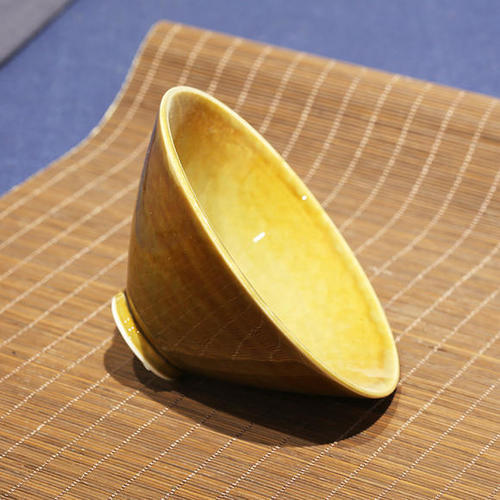
Wan (碗) is made of porcelain and used to hold tea liquid.
Ben (畚) is made of white stem or leaf of cattail and used to support bowls.
Zha (札) is made of cornel wood and palm skin and used as a brush.
Di Fang (涤方) is made of Catalpa wood and used to hold washing water and tea wares.
Zi Fang (滓方) is also made of Catalpa wood and used to hold tea dregs.
Jin (巾) is made of rough silk and used to clean tea wares.
Ju Lie (具列) is made of wood or bamboo and in the shape of a bed or shelf. It is used to store and display all tea utensils.
Dou Lan (都篮) is made of bamboo skin and used to hold all tea utensils.
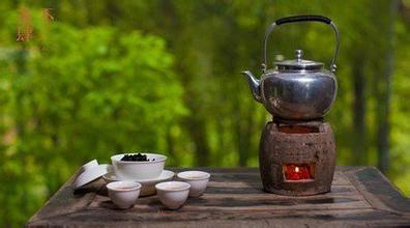
Do not bake cake teas over the flickering fire, otherwise tea leaves will be heated unevenly. The tender tea leaves are steamed first. And then grind the hot steamed leaves. Put the ground tea leaves over the fire to bake. Put the baked tea leaves in a paper bag to keep its aroma. Grind the leaves into powder after they become cold. It is recommended to use charcoal fire to bake cake teas. If the charcoal has been used to bake meat, it is not suitable for baking tea leaves.
The best water to boil tea leaves is from mountains, the second-best is from rivers and the third-best is from wells. When the water is boiled, put some salt into it. Pour the tea liquid in a tea bowl and enjoy it.
Do not use too much water to boil tea leaves, otherwise the liquid flavor will be too light. Premium quality tea liquid is light yellow in color and has an overflowing fragrance.
To quench thirst, drink water. To relieve the loneliness and grief, drink wine. To find refreshment for mind and body, drink tea.
Tea, one of popular drinks, was first used by Shennong. Duke of Zhou made a record on tea, thus making it widely known. Many Chinese famous ancients like to drink tea, such as Yan Ying of the State of Qi in the Spring and Autumn Period, Yang Xiong and Sima Xuangru in the Han Dynasty, and Wei Yao of the State of Wu in the Three Kingdoms. Drinking tea has become more and more popular and is brought to a very high level in the Tang Dynasty. Drinking tea is a must for each and every family in China’s ancient cities, such as Xi’an, Luoyang, Jiangling and Chongqing.
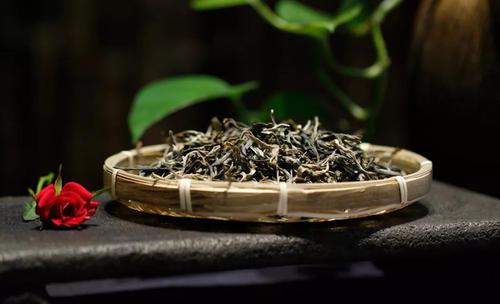
There are many types of tea, such as loose tea and cake tea. If you want to drink the cake tea, you need to cut it into small pieces with a knife. After baking and grinding, put the tea leaves in the earthenware. And then pour boiled water into it to brew the tea leaves. Of course, you may add some spices to the tea leaves, such as green onion, ginger, jujube, orange peel, cornel and mint.
People are adept at building houses, making fine clothes, and producing delicious food and precious wine. However, people are not good at drinking tea. Generally speaking, there are nine difficulties in tea, namely production of tea leaves, quality identification of tea leaves, tea wares, degree of heating, water quality, baking methods, grinding methods, boiling methods and tea-drinking habits.
If you pluck tea leaves in a cloudy day and bake them at night, you will produce no high-quality tea leaves. If you chew tea leaves in your mouth to identify their flavor, or if you smell them with your nose to identify their aroma, you will make no proper identification. If the tea wares are with an unpleasant odor, such as the smell of fish or seafood, they are not suitable for making tea. If the charcoal has been used to bake meat, it is not suitable for baking tea leaves. If the water flows too fast or too slow, it is not suitable for brewing tea leaves. If you bake tea leaves unevenly, you will produce no high-quality tea leaves. If the ground tea leaves are too fine and become green powder, the grinding method is unacceptable. If you stir the tea leaves in the saucepan too fast, you will produce no high-quality tea liquid. If you only drink tea in summer and do not do so in winter, you will not develop good tea-drinking habits.
There is a record in Duke Zhou’s “Erhya” that “Jia (槚) is a kind of bitter tea.”
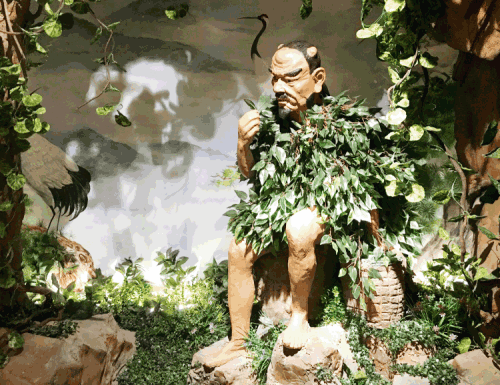
There is a record in “Shennong · The Classic of Food” that “Drinking tea for a long time makes people feel energetic.”
There is a record in “Guangya” that “Tea growers pluck tea leaves in Jingzhou (now western Hubei) and Bazhou (now eastern Sichuan). They compressed the tea leaves into cake teas. If cake teas are made from tea leaves that are not tender enough, tea growers will use rice-water to steep the leaves. If they want to boil and drink tea, they need to bake the leaves first. After the leaves turn to red, grind them into powder. Put tea powder in the porcelain and pour boiled water into it. Sometimes, they add green onion, ginger and orange peel to the tea leaves. Drinking the liquid can help sober up.”
Shannan: The best tea leaves are produced in Xiazhou, the second-best are from Xiangzhou and Jingzhou, the third-best are from Hengzhou, and the fourth-best are from Jinzhou and Liangzhou.
Huainan: The best tea leaves are produced in Guangzhou, the second-best are from Yiyang Prefecture and Shuzhou, the third-best are from Shouzhou, and the fourth-best are from Qizhou and Huangzhou.
Zhexi: The best tea leaves are produced in Huzhou, the second-best are from Changzhou, the third-best are from Xuanzhou, Hangzhou, Muzhou and Xizhou, and the fourth-best are from Runzhou and Suzhou.
Jiannan: The best tea leaves are produced in Pengzhou, the second-best are from Mianzhou and Shuzhou, the third-best are from Qiongzhou, Yazhou and Luzhou, and the fourth-best are from Meizhou and Hanzhou.
Zhedong: The best tea leaves are produced in Yuezhou, the second-best are from Mingzhou and Wuzhou, the third-best are from Taizhou.
Qianzhong: Tea leaves are produced in Enzhou, Bozhou, Feizhou and Yizhou.
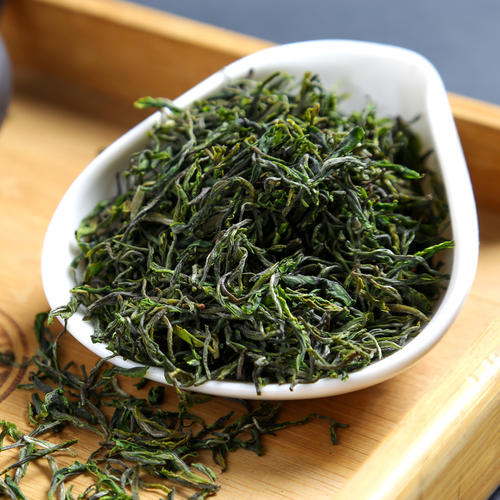
Jiangxi: Tea leaves are produced in Ezhou, Yuanzhou and Jizhou.
Lingnan: Tea leaves are produced in Fuzhou, Jianzhou, Shaozhou and Xiangzhou.
Tea leaves produced in these 11 areas, namely Sizhou, Bozhou, Feizhou, Yizhou, Ezhou, Yuanzhou, Jizhou, Fuzhou, Jianzhou, Shaozhou and Xiangzhou, have yet to be studied further. I have received some tea leaves produced in these areas. After drinking the tea liquid, I do think it has a good taste.
Here are some tips for processing tea leaves and using tea utensils. Before or after the Cold Food Festival in spring, tea growers go outside and gather in temples or tea gardens to pluck tea leaves. After the tea leaves are plucked, they are steamed immediately. And then, tea growers grind the steamed leaves and bake them over a fire. Under such conditions, the following seven kinds of tea utensils are unnecessary:
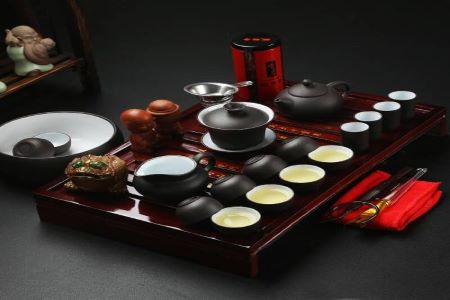
Qi (棨), also known as Zhui Dao (锥刀), is made of solid wood and used to pierce the cake tea.
Pu (扑), also known as Bian (鞭), is made of bamboo and used to string cake teas together.
Bei (焙) is a pit surrounded by low walls.
Guan (贯) is made of bamboo and used to bake tea leaves.
Peng (棚), also known as Zhan (栈), is a wooden shelf placed on Bei (焙) to bake tea leaves.
Chuan (穿) is made of bamboo or bark and used to string cake teas together.
Yu (育) is a wooden frame wrapped by thin bamboo strips and paper. It is used as a dehumidifier.
Accordingly, the seven tea-making processes related to the seven tea utensils are also unnecessary.
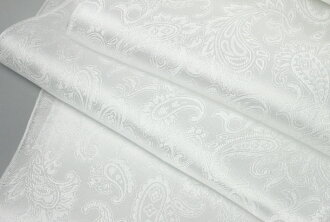
Use four or six pieces of white silk to record the above content. Hang the white silk beside the seats. Therefore, it is easy for tea drinkers to study the tea-related knowledge, such as origin of tea, utensils for plucking and processing tea leaves, methods for producing tea, utensils for producing tea, methods for boiling tea leaves, tips for drinking tea, anecdotes and medicinal effects of tea leaves, production areas and conditions for using tea utensils. In this way, The Classic of Tea is finished.
If tea growers boil tea leaves in a pine forest and there are stones for sitting upon, the following utensil is unnecessary:
Ju Lie (具列) is made of wood or bamboo in the shape of a bed or shelf. It is used to store and display all tea utensils.
If tea growers use a saucepan to boil water over the wood fire, the following utensils are unnecessary:
Feng Lu (风炉) is made of copper or iron and looks like an ancient tripod. It is used to ventilate the stove, hold the charcoal ash and brew tea leaves.
Tan Wo (炭挝) is made of hexagonal iron bars and one Chi in length. It is used as a hammer to smash charcoal.
Huo Jia (火夹), also known as Zhu (箸), is actually coal tongs. It is made of iron or wrought copper.
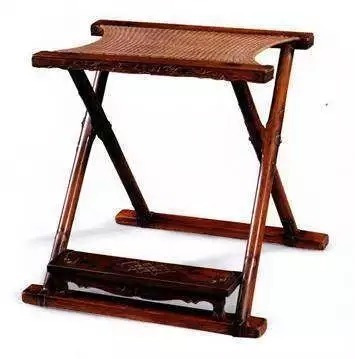
Jiao Chuang (交床) is made of a wooden cross and used to support the saucepan.
If tea growers boil water near a stream, the following utensils are unnecessary:
Shui Fang (水方) is a wooden water container, with a capacity of one Dou (斗). The internal and external gaps of the water container are painted.
Lu Shui Nang (漉水囊) is used for the filtration of water. Its skeleton is made of cast copper, bamboo or wood. Its filtration bag is made of bamboo skin.
Di Fang (涤方) is made of Catalpa wood and used to hold washing water and tea wares.
If the tea leaves can be ground into powder, the following utensil is unnecessary:
Luo (罗), with a round shape, is made of giant bamboo. Cotton or silk is fixed at the bottom of Luo.
If travelers intend to climb the cliff or enter a cave, they may bake and grind the tea leaves at the mountain pass. The baked and ground tea leaves may be wrapped by a paper bag or box. They may use a bamboo basket to hold Piao (瓢), Jia (夹), Zha (札) and Shu Yu (孰盂). Under such conditions, the following utensils are unnecessary:
Nian Cao (碾槽) is mainly made from tangerine tree. It is used as a mill groove.
Dou Lan (都篮) is made of bamboo skin and used to hold all tea utensils.
However, it is better for noble families living in the city to possess all 24 tea utensils. Lacking any tea utensil may make them lose interest in tasting the fragrant tea.
